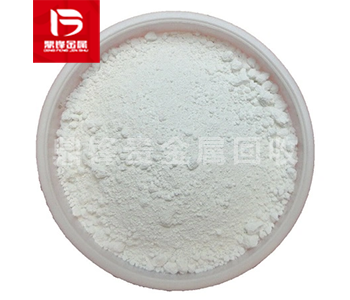
Indium Oxide Recycling
Indium oxide (In₂O₃) is an inorganic compound composed of the elements indium and oxygen, usually in the form of a white or pale yellow powder. Waste indium oxide is one of the recycling sources for indium-containing precious metal catalysts. The recycling sources for indium-containing precious metal catalysts include indium sulfide recycling, indium hydroxide recycling, indium fluoride recycling, indium acetate recycling, and indium chloride recycling.
- Parameter
- Related Questions and Answers
-
Name : Indium oxide
-
Use : Manufacturing materials for transparent conductive films, solar cells, touch screens, etc.
-
Application Areas : Electronics, Optoelectronics, and Photovoltaics
-
Appearance and properties : White or pale yellow powder
-
Settlement Method : On-site payment
-
Recycling Type : Indium recycling
-
Door-to-door recycling:worldwide
-
Customer service: Free content testing and door-to-door recycling
Indium Nitrate Recycling
Indium nitrate (In(NO₃)₃) is an inorganic compound formed by the reaction of indium with nitric acid, usually in the form of white crystals or a colorless solution. Waste indium nitrate is one of the raw materials for recycling indium-containing precious metal catalysts. Other raw materials for recycling indium-containing precious metal catalysts include indium sulfide recycling, indium hydroxide recycling, indium fluoride recycling, indium acetate recycling, and indium chloride recycling.
Search : Indium Nitrate RecyclingIndium Slag Recycling
Indium slag refers to the solid residue containing indium and other metal impurities produced during the indium smelting process due to the inability to completely extract or separate the indium metal in the smelting raw materials. Indium slag is one of the important sources of indium-containing waste recycling. Indium-containing waste recycling also includes indium mud recycling, indium slag recycling, indium ingot recycling, indium wire recycling, indium block recycling, indium particle recycling, indium rod recycling, etc.
Search : Indium Slag RecyclingIndium Target Recycling
Indium target refers to the target material used in thin film deposition technology, usually high purity indium metal or indium alloy. Recycling of waste ITO targets is one of the rare precious metal target recycling. Rare precious metal target recycling also includes silver target recycling, ruthenium target recycling, platinum target recycling, gold target recycling, iridium target recycling, germanium target recycling, tantalum target recycling, etc.
Search : Indium Target RecyclingIndium Oxide Recycling
Indium oxide (In₂O₃) is an inorganic compound composed of the elements indium and oxygen, usually in the form of a white or pale yellow powder. Waste indium oxide is one of the recycling sources for indium-containing precious metal catalysts. The recycling sources for indium-containing precious metal catalysts include indium sulfide recycling, indium hydroxide recycling, indium fluoride recycling, indium acetate recycling, and indium chloride recycling.
Search : Indium Oxide RecyclingProduct Details
Indium oxide (In₂O₃) is an inorganic compound consisting of the elements indium and oxygen, usually in the form of a white or pale yellow powder. Indium oxide is an important semiconductor material that is widely used in electronics, optoelectronics, and photovoltaics. One of its best-known applications is as a material for transparent conductive films, especially in devices such as liquid crystal displays (LCDs), touch screens, and solar cells. Indium oxide has excellent electrical conductivity and transparency, and can provide stable electrical conductivity without affecting light transmittance, making it the primary material for transparent conductive oxides (TCOs).
There are several main methods for producing indium oxide (In₂O₃):
1. High-temperature oxidation method: The high-temperature oxidation method is one of the most common methods for producing indium oxide. This method is usually carried out by heating metallic indium to high temperatures in air and reacting indium with oxygen to form indium oxide. The reaction process is: 4In+3O 2→2In2O3 This method is simple and direct, and is suitable for industrial-scale indium oxide production.
2. Wet synthesis method (chemical precipitation method): The wet synthesis method is a method of producing indium oxide by chemical reaction. Usually, indium salt solution (such as indium chloride, indium sulfate, etc.) is reacted with an alkaline solution (such as sodium hydroxide, aqueous ammonia, etc.) to precipitate indium hydroxide or indium precipitate, which is then calcined to convert it into indium oxide. This method is relatively gentle and suitable for producing high-purity indium oxide.
3. Vapor deposition: Vapor deposition (CVD or MOCVD) is a technology in which gas precursors (such as trimethylindium and indium alkane) are reacted with oxygen at high temperatures to produce thin films of indium oxide. Vapor deposition is often used to produce transparent conductive films (such as ITO films), and has the advantage of precisely controlling the film thickness and quality, making it suitable for the production of electronic products such as displays and touch screens.
4. Sol-gel method: The sol-gel method is a wet chemical method that reacts indium salts (such as indium chloride) with organic solvents (such as alcohol) to produce a sol solution, and then obtains indium oxide gel through a gelation process. After heat treatment, indium oxide is converted into solid indium oxide. This method can produce indium oxide films with high purity and good uniformity, and is suitable for fields such as electronics and optoelectronics.
5. Thermal decomposition method: The thermal decomposition method is usually used to prepare indium oxide nanomaterials or micron materials. In this process, indium compounds (such as indium chloride and indium sulfate) are heated and decomposed to produce indium oxide. This method can prepare indium oxide particles with uniform particle size, and is widely used in the synthesis of high-performance nanomaterials.
Waste indium oxide is one of the recycling sources for indium-containing precious metal catalysts. The recycling sources of indium-containing precious metal catalysts include indium sulfide recycling, indium hydroxide recycling, indium fluoride recycling, indium acetate recycling, indium chloride recycling, etc. If you need to recycle indium-containing precious metal catalyst waste, please contact our 24-hour service hotline. Dingfeng Precious Metal Recycling Refining Plant has its own recycling refinery that does not use middlemen to make profits from price differences, and has a professional technical team and customer service staff to provide one-to-one service and ensure customer privacy during the recycling process.

